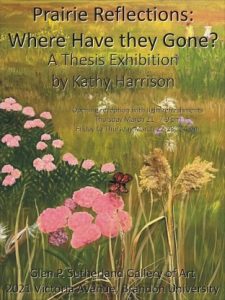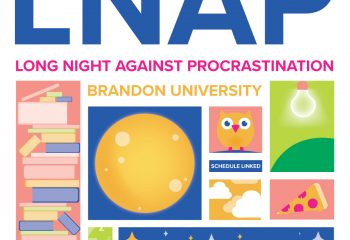
- This event has passed.
‘Prairie Reflections: Where have they gone?’ Opening Reception
Event Navigation
 On Thursday, March 21 at 7 p.m. Prairie Reflections: Where have they gone? a Thesis Exhibition by Kathy Harrison a student in the IshKaabatens Waasa Gaa Inaabateg Department of Visual Art at Brandon University (BU) will open at the Glen P. Sutherland Gallery of Art. Admission is free. Following the reception, the exhibition will be open from 1–4 p.m. daily from March 22–28.
On Thursday, March 21 at 7 p.m. Prairie Reflections: Where have they gone? a Thesis Exhibition by Kathy Harrison a student in the IshKaabatens Waasa Gaa Inaabateg Department of Visual Art at Brandon University (BU) will open at the Glen P. Sutherland Gallery of Art. Admission is free. Following the reception, the exhibition will be open from 1–4 p.m. daily from March 22–28.
Now living in Brandon, Harrison grew up on a farm in Manitoba’s Interlake surrounded by the flora and fauna of the Tall Grass Prairie (TGP). She has watched with concern the marked decrease in the TGP species, a trend that she addresses in her exhibition. Harrison would like to challenge visitors to consider the benefits of restoring TGP species, with the understanding that small changes multiplied many times over can create big changes. You don’t have to own an acreage to incorporate TGP plants into your garden, and pollinators will thank you.
The exhibition of paintings and mixed media installation illustrates the decline in the Tall Grass Prairie and offers hope for future restoration.
Swift Fox, Whooping Crane and Burrowing Owl
Swift Fox: I did not have the opportunity to see the housecat sized Swift Fox in the wild while growing up on the Prairies, as it had not been seen in Canada since the1930’s, and was designated as extirpated from Canada in the 1970’s. I have included it in this exhibition because the reintroduction of the Swift Fox into Canada is considered to be a great success story. Government and private agencies worked together with conservationists in the United States to reintroduce the Swift Fox into Saskatchewan and Alberta. These are now considered to be small (just over 500 foxes) but stable populations[1].
Whooping Crane: Once numbering in the thousands across North America, by the 1940’s the whooping crane was at risk of extinction. Loss of wetland habitat continues to impact on this species. Saving the Whooping Crane from extinction is another example success in species restoration with co-operation between the United States and Canada. However, whooping crane pairs have only 1 offspring per year, and their survival as a species in Canada is far from secure with just over 300.[2]
Burrowing Owls: Contrary to what their name suggests, Burrowing Owls do not actually do any burrowing, but rather take up residence in abandoned burrows created by prairie dogs, ground squirrels, foxes and badgers. These tiny owls stand less than 10 inches tall with a 20 inch wing span. Once common on grasslands from Canada to Mexico, they are now both provincially and nationally endangered. Due to loss of habitat Manitoba has less than ten breeding pairs of Burrowing Owls remaining. [3]
[1] “Swift Fox”, Nature Conservancy Canada
[2] “Whooping Crane”, Government of Canada, Wildlife Species Canada
[3] “Burrowing Owl, Manitoba’s Species at Risk”, Economic Development, Investment, Trade and Natural Resources, Province of Manitoba
Brandon University is committed to being an accessible institution. To ensure that any event is available to all who are interested in attending, please advise us in advance of any accessibility considerations. Accessibility contact: communications@brandonu.ca



